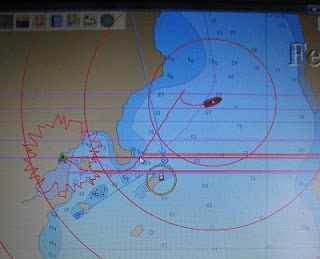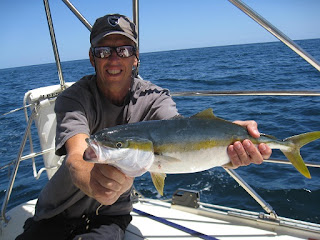Hanging Out in Puerto Escondido - It’s been relatively quiet since our friends Lisa and Joe
flew back home to the bay area. Lisa
took some terrific pictures and is sharing them on her Google Album HERE.
Mostly we’ve spent the past couple of weeks, sightseeing,
snorkeling, stargazing, doing our One Chore Per Day and watching a plethora of boats sail
into, and then out of Puerto Escondido.
Tom and I wonder why many of these boats stay only a night or two before sailing on to further adventures. They probably wonder why that big red boat is content to stay put when there are so many beautiful anchorages within just a few hours sail from here. Maybe we’re lazy? Maybe it’s a philosophical difference in cruising styles? But Tom and I really enjoy getting to know a place, to know the people who work and live there, to learn their names and say “Hi” to them on a daily basis. It took us about a week to get to know Pedro (aka Pedrito), the character (and I do mean character) who runs the store and upstairs Porto Bello restaurant...
 |
Tom and I wonder why many of these boats stay only a night or two before sailing on to further adventures. They probably wonder why that big red boat is content to stay put when there are so many beautiful anchorages within just a few hours sail from here. Maybe we’re lazy? Maybe it’s a philosophical difference in cruising styles? But Tom and I really enjoy getting to know a place, to know the people who work and live there, to learn their names and say “Hi” to them on a daily basis. It took us about a week to get to know Pedro (aka Pedrito), the character (and I do mean character) who runs the store and upstairs Porto Bello restaurant...
 |
| Pedrito serenades the ladies. |
...Ulysses
who maintains the grounds, Lenin and Gabriel the servers in the restaurant...
 |
| Lenin doing his magic behind the bar. |
...Candelario (Candi) the waiter at the hotel up the road, Raquel who works in the marina office, Carlos who is in charge of boat cleaning, Salvador who works for the fishing boats, and all the other people who work here.
Puerto Escondido, like many other parts of Mexico, had planned to have a large community. An entire neighborhood of canals, bridges and plots was zoned out, construction was started, but ultimately abandoned. A boatyard and small marina remain. I wonder if they will ever finish the homes in this terrific location?
 |
| Abandoned neighborhood as seen from under canal bridge. |
 |
| Connie helps run the local radio net. Her radio handle is "Sun Lover". |
We would never get to meet and know these folks if we only stayed here one or two nights.
We’ve also enjoyed getting to know our pals on Iolanthe and
Telitha a bit better. They are truly wonderful people that we met up in Bahia Concepcion. Through some bad luck for them (Iolanthe: broke a backstay, wrapped a jib sheet around her prop and broke some motor mounts; Telitha: some wire and hose came loose from engine, wrapped around prop shaft and destroyed their engine seal) both boats ended up in Puerto Escondido to effect their repairs.
 |
| Tom and Nick (Iolanthe) enjoy a beer. |
Tom read about a hiking trail that goes from our anchorage
over the hill to a beach at the next cove called El Chenque, near Juncalito. It was a pleasant hike but we were distressed
to see an excess of litter and trash at the beach. Hence, we christened it El
Janky, or Janky Beach.
(Recycling seems to be a problem in Mexico, and we have not
seen an adequate recycling program since we left Ensenada. We met a guy who is
part of an organization, EarthComp, that is trying to start a recycling program in Loreto
and the area. So far they are collecting plastic, although they’re not quite
sure what to do with it yet. I sure hope they can make a go of it. We also met Salvador from one of the fishing boats who collects cans and takes them to a recycling center somewhere.)
While wading in the
waters of Janky Beach we were absolutely amazed to find a rare, deep-water
squid swimming along the shore. We’re not sure, but it appeared that this Vampire Squid was likely
in its death throes, possibly by-catch from a fishing net? We’ll never be sure,
but it was an absolutely beautiful animal. Unfortunately none of us had
cameras, but here is a picture from National Geographic:
 |
| National Geographic pic of Vampire Squid. Yes! We really saw this! |
Another afternoon we dinghied over to one of the coves in
our anchorage to see if the snorkeling was any good, and we were surprised to
find that even though the visibility wasn’t so great, we managed to see tons of
schooling fish such as Mojarras and Mullets, not to mention several types of
angel fish, butterfly fish, scallops and oysters, and many schools of tiny baby fish
that use this protective cove as their nursery. Tom even dove down and found a
couple of lobsters in their hidey holes. We’ve been snorkeling in our bay a
couple of times and it’s encouraging to see so much sea life in our anchorage.
 |
| Baby fishies swim around our boat every morning. |
Lovely Loreto - In addition to entertaining ourselves at beautiful Puerto
Escondido we have also enjoyed a couple of day trips into Loreto, a town we
fell in love with in March 2012 when we flew down with some friends as part of
a Baja Bush Pilots whale watching excursion.
 |
| March 2012 with Mary and Lou, flying to Loreto. |
In 2012 Loreto was (and still is) recovering from severe hurricane flooding and was repairing and constructing its shore side Malecon. We were delighted to discover that now, 2013, the Malecon is nearly completed and is a beautiful sidewalk along the ocean.
 |
| The Malecon in 2013, looking great. |
 |
| Downtown Loreto - This look hasn't made it to the states yet. |
 |
| Lucha Nick will fight for a deal. |
 |
| Tom rents a bike in Loreto |
But even though we have truly enjoyed Puerto Escondido it’s
feeling like our season is winding down and we have to start thinking about
getting down to La Paz and putting Cinnabar away for the summer.
A few days ago we had a going away party for Telitha since
they would be leaving the next morning for their return trip to San Carlos on the mainland.
 |
| We celebrate with our last bottle of Tres Mujeres wine. |
 |
| Telitha gets ready to leave for her journey back to San Carlos. |
Then Iolanthe went back into the water...
 |
| In the water at last!! |
...Arthur returned from
La Paz with Iolanthe’s new backstay...
 |
| King Arthur and Prince Nick |
...we got the backstay installed and now Nick
and Arthur are getting ready for Iolanthe’s sail back down to La Paz and eventually to San Diego.
I'm not Sonja, my name is Sylvia - A funny side story. Nick's dad Arthur was absolutely enamored to hear that my sister Sonja works at Ridge Winery. Apparently Arthur is completely obsessed (OK, maybe not COMPLETELY...) with the famous "The Judgment of Paris" wine competition of 1976, where one of the French judges rated Ridge Winery's red as #1, even above all the French wines (gasp!!). After learning that, every time Arthur sees me, does he say "Hello Sylvia"? Nope, he tenderly takes my hand and murmers, "You're Sonja's sister." Every friggin' time! OK Sis, you have fair warning, I KNOW that Arthur is going to visit you at Ridge winery and you'd better take good care of him!
Wrapping it up - Here on Cinnabar we are enjoying our last days in Puerto Escondido, doing some repairs and fixes on the boat, paying bills and catching up on emails, and reconnecting with other cruising pals we have met along the way. We will probably start heading south in a couple of days (but not before the SJ Shark's game Tuesday!), stopping at
various anchorages and letting our livers recover as we say our farewells to beautiful Baja. I'm not Sonja, my name is Sylvia - A funny side story. Nick's dad Arthur was absolutely enamored to hear that my sister Sonja works at Ridge Winery. Apparently Arthur is completely obsessed (OK, maybe not COMPLETELY...) with the famous "The Judgment of Paris" wine competition of 1976, where one of the French judges rated Ridge Winery's red as #1, even above all the French wines (gasp!!). After learning that, every time Arthur sees me, does he say "Hello Sylvia"? Nope, he tenderly takes my hand and murmers, "You're Sonja's sister." Every friggin' time! OK Sis, you have fair warning, I KNOW that Arthur is going to visit you at Ridge winery and you'd better take good care of him!
More photos of Puerto Escondido and Loreto can be found HERE.
 |
| We sacrifice precious rum to Mighty Neptune...no more breakdowns, please! |


































.JPG)

